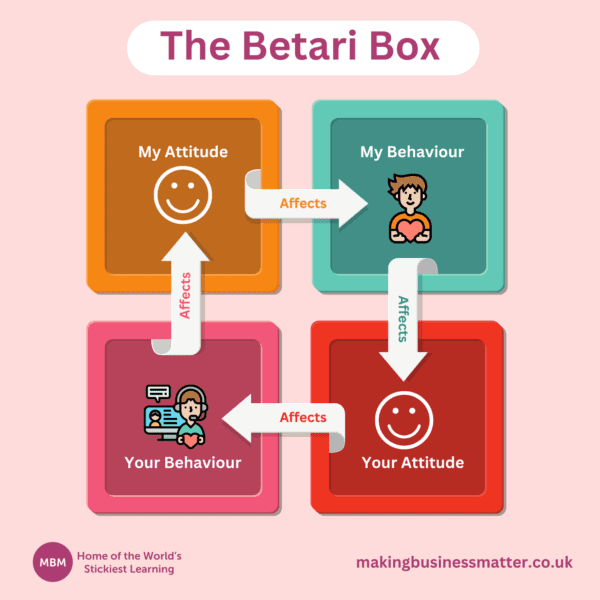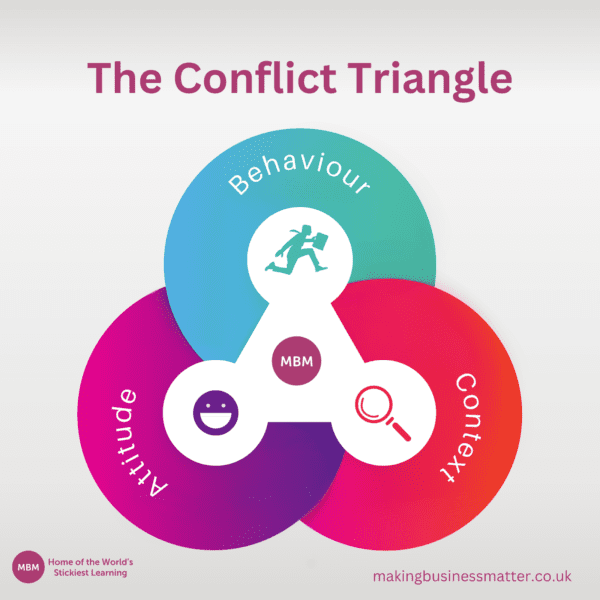Also known as Betari’s Box, Betaris Box, and the Cycle of Conflict
The Betari Box is a model that visualises the attitude-behaviour cycle: “My attitude is going to affect my behaviour, which is going to affect your attitude, which will, in turn, affect your behaviour.”
People’s attitudes and behaviours in the workplace affect those of others, so they react either positively or negatively. The Betari Box enables you to manage yourself when you’re worked up and step in to resolve conflicts.
Picture two coworkers, Alice and Bob, caught up in a heated conversation. When Alice became tense, her behaviour reflected her feelings and affected Bob’s mood without them realising it. This created a chain reaction where Bob mirrored Alice’s reactions, causing a cycle of negativity.
Overall, This scenario perfectly reflected the core lesson of the Betari Box: how attitudes and behaviours shape our work relationships. But the Betari Box was more than just an idea; it was like a superpower, giving people the ability to understand and change these patterns.
As this article explains, Betari’s Box shows we all have the power to break the attitude-behaviour cycle. Being compassionate and taking a positive attitude when people are being difficult, isn’t being soft, it’s showing leadership.
Once you grasp Betari’s Box, you can turn tricky situations around, with remarkable results. And as we’ll reveal, it’s even used by the College of Policing, which works with police forces around the UK. Which means it must be good.
What is the Betari Box?
The Betari Box, also known as the Betari’s Box or Betaris Box, is a simple circular diagram that shows how our attitude and behaviour and other people’s link together:

Click the image above for a higher resolution.
The Betari Box model helps to resolve squabbles and disputes within teams. It also helps to sort out conflicts between different functions in a company, between companies and suppliers, or businesses and local communities… in fact, pretty much anyone.
Where Did the Betari Box Model Come From?
According to toolshero.com, the origins of the Betari Box are unknown. The name comes from the Persian city of Betari, which is in present-day Iran. Toolshero says Betari is also mentioned in the Bible.
It’s unknown what the link is between either of these to Betari’s Box, but if you like, you can see the Bible as the story of how a boss understands his people’s attitude-behaviour cycle and steps in to resolve it. And present-day Iran is a nation, like ours, with its share of conflicts, which understanding Betari’s Box and the attitude-behaviour cycle would certainly help sort out.
What Does Betari’s Box Suggest?
Betari’s Box suggests that by adopting the attitude-behaviour cycle and being in the moment, generally, you can see what’s happening around you and break the circle, turning negative into positive.
What Does Adopting the Attitude-behaviour Cycle Suggest?
By adopting the attitude-behaviour cycle as outlined, you are strategically placing yourself back in the driver’s seat of the situation. Accordingly, with the premise we set forth at the beginning, it’s imperative to underscore that this approach is indeed a testament to strength, transcending any perception of vulnerability.
As you dedicate your workday to honing the appropriate attitude, you’ll witness a remarkable transformation that goes beyond the surface. Pay close attention to how people respond to your disposition, while simultaneously keeping a watchful eye on their corresponding behaviors. This keen observation will serve as a compass for recognising the profound ripple effect that your attitude can induce, simultaneously, shaping interactions and influencing outcomes.
In essence, the practice of adopting and implementing the attitude-behaviour cycle embodies a shift towards proactive engagement. Finally, through steadfast determination and heightened awareness, you’ll navigate situations with a renewed sense of control and efficacy.

The Behaviour Box
Here’s an example of how easy it is to get yourself and your co-workers stuck in a behaviour box. Your journey to work is more stressful than usual, and when you get there, you’re in a negative mood and behave inappropriately. Your temper’s short, so you yell and shout at your team. This upsets them, obviously, so they repeat and reflect your attitude and behaviour back to you. Your assistant is sulky and unhelpful for the rest of the day, and your colleagues are resentful. Consequently, no positive communication happens.
Betari’s Box Exercises You Can Do
Grasping the idea of the Betari Box enables you to work on yourself and create a more positive mindset. One thing you can do is practise gratitude. Show appreciation face to face, as well as in things like phone calls, texts and emails, you might think this is the last thing you want to do. But doing this regularly exercises the brain to think more positively and creates new neural pathways in our brain, helping us achieve a more constructive perspective. And it lowers blood pressure too!
The Betari Box Can Transform Your Working Relationships

There are more ways you can use Betari’s Box to become the best version of yourself.
1. Help Yourself:
When you’re in a negative mood, stop what you’re doing. Take a moment to think about why you’re feeling like this. Often it can begin with an insignificant event, which then spirals downwards. You can consciously decide to break out of the cycle by focusing on something positive.
2. Be Self-aware:
Personal problems, like ill health, relationship difficulties, family illness or bereavement are bound to affect your mood and your reactions at work, and simultaneously, affect your focus and motivation. So are everyday stresses like moving house. Talking to your line manager and confiding in colleagues will help.
3. Help Your Colleagues:
If a workmate seems to be stuck in a negative cycle, you can choose how you respond. Just because someone’s negative towards you, it doesn’t mean you need to be negative back. Generally, treat people like you’d like them to treat you.
4. Let’s Get to the Bottom of This:
If your colleagues are persistently negative, don’t just put up with it. It’s worth trying to explore the reason. Regardless, explain the Betari Box model to them, and highlight the consequences of their behaviour on team morale and productivity and their own quality of life.
It’s very easy to get drawn into a cycle of negativity when someone’s being negative towards you, as you can get negative towards them, and the cycle goes on. generally, if this happens. you can agree to draw a line under what’s happened, forget their past negativity, and move on.
5. Practise Empathy:
Understanding others can help you get out of a negative cycle once you are in it. They may have personal problems and stresses you can only imagine. Show genuine interest, and be kind and compassionate. And remember Equity, Diversity, and Inclusivity.
In today’s increasingly diverse workplaces, the convergence of individuals from distinct backgrounds and cultures, or those embodying various forms of diversity, brings to light an essential reality. The stresses they may encounter, often unknown to us, significantly influence their interactions, including their responses to both you and others.
The Window of Tolerance
This idea of people facing stresses we have no idea about brings us to the Window of Tolerance. This affects the way we react to things and how much head space we have.

Hyperarousal is when you commonly experience a heightened sense of anxiety. This makes you more sensitive or overly responsive to things that happen in daily life. You need to calm yourself.
If you see this happening with someone. Generally, try to empathise with them, and be compassionate. Help them get back into their window of tolerance, and do what’s appropriate.
Something else to be aware of is that ‘fight or flight’ responses happen in the hyperarousal state. These can include:
- Anxiety
- Panic
- Fear
- Defensiveness
- Anger
- Hypervigilance
A common condition following trauma or anxiety, hypervigilance is a state of increased alertness. This can make people extremely sensitive to their surroundings. They’re alert to any hidden dangers, whether from other people or the environment. Sometimes hypervigilance is a symptom of an underlying mental health condition.

>> Mental Health Coaching Cards <<
>> Access on Amazon <<
When you’re navigating conditions that include symptoms of fear, avoidance, or extreme stress reactions, you might experience irrational or exaggerated fear about a situation or event. Hyperarousal keeps your mind permanently “on.” It makes it difficult to sleep, eat, manage emotions, or, as this is a business article, concentrate on work. Accordingly, if hyperarousal escalates to the most intense level, this may result in dissociative rage and feelings of hostility.
Betari’s Box and Conflict Resolution
In the College of Policing’s web post on conflict management skills for UK police forces, they make reference to the Betari Box. Accordingly, they aptly explain that this model “describes how people can get locked into a vicious or virtuous circle of communication, based on how their attitudes and behavior respond to each other.”
As its name aptly indicates, the College of Policing stands as a professional body that encompasses all roles within policing. Given their expertise, if anyone holds the knowledge on breaking these cycles and preventing situations from escalating, it’s undoubtedly these professionals. Furthermore, their insights are crucial for learning how to navigate and mediate conflicts effectively, ensuring safety and order in society.
Additionally, the Betari Box serves as a valuable tool not only in policing but across various domains. Finally, This model’s wisdom can help people comprehend and influence the dynamic interplay between attitudes and behaviours, fostering more positive and constructive interactions.
Elements of Conflict Management
The College of Policing says effective conflict management involves the following elements:
- Situational awareness
- Dialogue and communication
- Emotional awareness and self-regulation
You can use all these elements to resolve business conflicts. Let’s look at them in more detail:
1. Situational Awareness:
- Stay focused and in the moment. Find out what’s happened, and look to break the circle, turning negative into positive. Judge carefully whether, when and how, to be assertive. Take control, but stay calm.
2. Dialogue and Communication:
- Start with active listening. Let people tell their side of the story, and listen. Being open to what a person is saying helps to build rapport, which could help reduce tension.
- Begin sentences with ‘I’ to personalise what you are saying, show leadership and again, establish rapport.
- Use your verbal and non-verbal communication and negotiation skills. Focus on understanding the motivations of others and showing empathy. Nod your head to indicate understanding. Paraphrase what they’ve told you, and finally, confirm you do understand.
- Pause after something meaningful to show you understand its importance, let the other person vent their frustration and simultaneously, give yourself time to think.
- Use open questions to draw out information. Repeat or echo words or phrases the other person has used.
- Avoid criticism, and praise appropriately. Generally, don’t take sides.
- Make impartial decisions and explain how you reached them.
- Show trustworthiness by being open and honest.
- Treat everyone with dignity and respect.
3. Emotional Awareness and Self-regulation:
- Be aware of your body language and how you come across to others.
- Use emotional labelling. Tell them you understand how this is affecting them. I can see you’re upset, this must be frustrating for you.
- Recognise your own stress, and don’t let it build up.
- Remember it takes a lot of effort to remain angry and aggressive, and the others are bound to calm down at some point.
- Understand people’s motivations and show empathy.
- Control your own emotions and stay calm.
Watch the Normality Return
As the conversation continues, bear in mind that communication is:
- Verbal: spoken words
- Para-verbal: Tone, pitch, volume
- Non-verbal: Facial expressions, eye contact, proximity, and body language such as gestures and posture
Make a note of the body language to avoid during a conflict:
- Keep your body language open and positive
- Use open-hand language
- Breathe deeply
- Respect personal space
- Be aware of your facial expressions
- Avoid making sudden movements
- Don’t stare
Try Some Pro-Social Modelling

When you’re dealing with problem individuals, think about Prosocial behaviour. This is behaviour intended to help other people. Experts say it requires three components:
- Ability to take another person’s perspective and recognise they are having a problem.
- Being able to determine the cause of the problem.
- The motivation to help them overcome the problem
In the justice system, they talk about pro-social modelling being a simple and effective technique that can contribute to behaviour change in ‘forensic clients.’
Individuals working with involuntary clients can model and reinforce pro-social values to elicit similar values in their clients. This is the advice given to prison officers. Generally, As a leader or manager in a workplace, hopefully, you won’t have to act quite like a prison officer! But one way you can interrupt the negative attitude/behaviour cycle is to act as a positive and motivating role model for your team.
Being reliable, punctual, fair, consistent, and respectful in all your interactions will make sure they see you as an example to follow. Furthermore, examples of such behaviours include helping, sharing, consoling, comforting, cooperating, and protecting people from potential harm.
Beyond the Betari Box: The Conflict Triangle
If you find the Betari Box helpful in thinking about conflict management, here’s another model you might also find useful, the Conflict Triangle. Think of the conflict as having three elements: the context or situation, the behaviour of those involved, and their attitudes.

Click the image above for a higher resolution.
Behaviour, attitudes and context all influence each other, and so changes in context can lead to changes in attitude and behaviour. Similarly, behaviour changes can lead to changes in attitude and ultimately the context. The conflict triangle, or ABC triangle, is a simple framework for exploring the impact and causes of conflict.
Typically, the ABC triangle is used in peacebuilding so it might seem melodramatic to talk about it here but bear with me. The Conflict Triangle acknowledges that conflicts are inevitable, but can be handled creatively to fulfil the needs of all parties. A solution must be acceptable to all parties to be sustainable.
This Is Between Me and You: Putting Tolerance and Social Modelling Into Practice
The attitude and behaviour cycle can be challenging if people have to work with colleagues who are very different. It’s particularly so in smaller businesses, where there’s no getting away from each other.
Tolerance means positively accepting people you don’t instinctively get along with. It means noticing when you feel they are irritating you, consciously or otherwise, taking ownership of your feelings and trying to understand them, changing your perspective and practising respect.
This might lead you to:
- Be more open to people from other generations.
- Include different subcultural groups.
- Welcome colleagues’ different traditions.
- Make LGBTQI+ colleagues feel safe.
Tolerance means turning round your attitudes and behaviour. Social modelling in the workplace goes further. It’s about modelling a visible example to others.
Here Are Some Social Modelling Tips for Leaders and Managers:
- Don’t just TELL people what to do: spend time explaining what is required, and letting them ask questions and gain insights.
- Show a positive work ethic: arrive early for work, leave late, take reasonable breaks, and see projects to completion.
- Refine your communication style: When the boss is consistently courteous, particularly in conflicts, team members are more likely to follow suit.
- Be honest: If you keep promises, admit mistakes, and ask for advice, again, others are likely to do the same.
- Finally, don’t play politics: People take cues from the boss about how to fit in. Showing you’re committed to fairness and giving others a chance will mean everyone focuses on the job, rather than playing games.
And Finally: What to Watch Out for
Classic symptoms of bad attitude-behaviour cycles:
- Low productivity.
- Team members feel disengaged and undervalued.
- A culture of blame and shame, not nurturing.
- Stress at work: People become anxious if they think they’re going to fail and not get the job done.
- People withdraw from engaging with fellow team members.
- More time off sick.
- Absenteeism and presentism, not doing the job they’re supposed to be doing.
- Lastly, mistrust of leaders and of management.
Suspicion and distrust among team members clearly inhibit them from doing great work. But if you as the leader set a great example, it has major benefits.
Classic symptoms of good attitude-behaviour cycles:
- Engagement
- Empathy
- Rapport
- Motivation
- Greater productivity
- Outperformance: surpassing expectations
We achieve our best work through what Stephen R. Covey calls Co-creation, Habit #7 in his 7 Habits of Highly Effective People, with everyone working together, putting aside their differences.
When there’s tension between you and your work colleagues, it can create negative attitudes, which are clearly not going to produce the results you all want. Lead the way back to positivity. Finally, remember the Betari Box. Change your attitude, and the others will follow.
Lastly, for more useful content like this, check out our YouTube channel and join our email newsletter below.
Updated on: August 17, 2023




